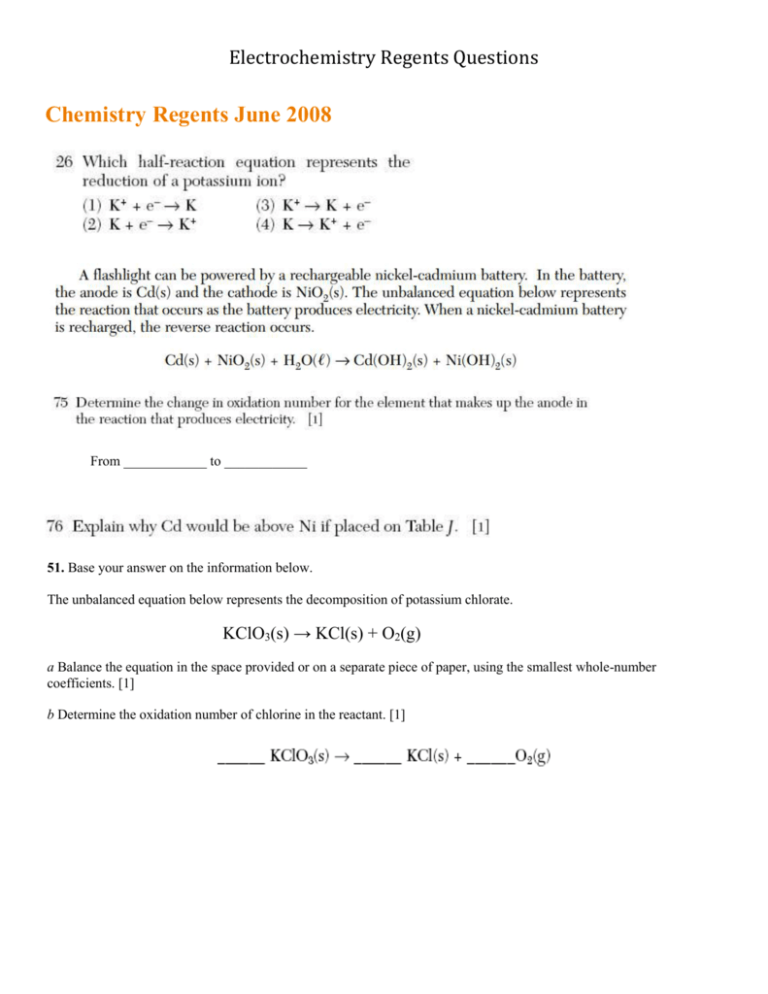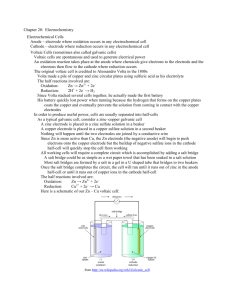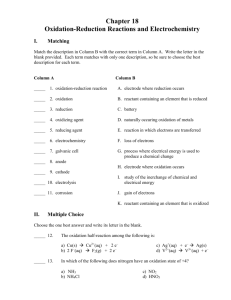Electrochemistry Regents Questions
advertisement

Electrochemistry Regents Questions Chemistry Regents June 2008 From ____________ to ____________ 51. Base your answer on the information below. The unbalanced equation below represents the decomposition of potassium chlorate. KClO3(s) → KCl(s) + O2(g) a Balance the equation in the space provided or on a separate piece of paper, using the smallest whole-number coefficients. [1] b Determine the oxidation number of chlorine in the reactant. [1] Electrochemistry Regents Questions June 2009 44. Given the balanced equation representing a reaction: Fe2O3 + 2Al → Al2O3 + 2Fe During this reaction, the oxidation number of Fe changes from (1) +2 to 0 as electrons are transferred (2) +2 to 0 as protons are transferred (3) +3 to 0 as electrons are transferred (4) +3 to 0 as protons are transferred June 2010 Two sources of copper are cuprite, which has the IUPAC name copper(I) oxide, and malachite, which has the formula Cu2CO3(OH)2. Copper is used in home wiring and electric motors because it has good electrical conductivity. Other uses of copper not related to its electrical conductivity include coins, plumbing, roofing, and cooking pans. Aluminum is also used for cooking pans. At room temperature, the electrical conductivity of a copper wire is 1.6 times greater than an aluminum wire with the same length and cross-sectional area. At room temperature, the heat conductivity of copper is 1.8 times greater than the heat conductivity of aluminum. At STP, the density of copper is 3.3 times greater than the density of aluminum. 81. Determine the oxidation number of oxygen in the carbonate ion found in malachite. Electrochemistry Regents Questions 24. Which statement describes one characteristic of an operating electrolytic cell? (1) (2) (3) (4) 44. It produces electrical energy. It requires an external energy source. It uses radioactive nuclides. It undergoes a spontaneous redox reaction. Given the balanced ionic equation representing the reaction in an operating voltaic cell: Zn(s) + Cu2+(aq) → Zn2+(aq) + Cu(s) The flow of electrons through the external circuit in this cell is from the (1) Cu anode to the Zn cathode (2) Cu cathode to the Zn anode (3) Zn anode to the Cu cathode (4) Zn cathode to the Cu anode June 2011 1. Which statement describes where the oxidation and reduction half-reactions occur in an operating electrochemical cell? (1) Oxidation and reduction both occur at the anode. (2) Oxidation and reduction both occur at the cathode. (3) Oxidation occurs at the anode, and reduction occurs at the cathode. (4) Oxidation occurs at the cathode, and reduction occurs at the anode. 46. Which balanced equation represents an oxidation-reduction reaction? (1) Ba(NO3)2 + Na2SO4 → BaSO4 + 2NaNO3 (2) H3PO4 + 3KOH → K3PO4 + 3H2O (3) Fe(s) + S(s) → FeS(s) (4) NH3(g) + HCl(g) → NH4Cl(s) June 2012 24 Which reaction occurs at the cathode in an electrochemical cell? (1) combustion (3) oxidation (2) neutralization (4) reduction Electrochemistry Regents Questions 72. State the direction of electron flow through the wire when the switch is closed. 73. Write a balanced half-reaction equation for the oxidation that occurs when the switch is closed. 74. Determine the number of moles of Al(s) needed to completely react with 9.0 moles of Ni2+(aq) ions. 75. State, in terms of energy, why this cell is a voltaic cell.








